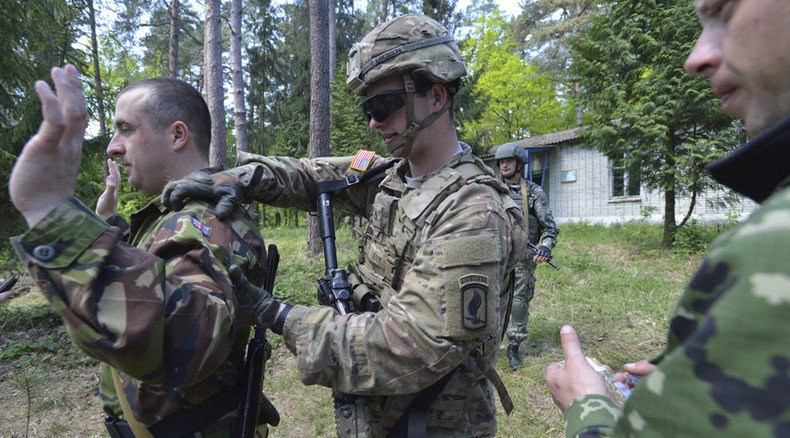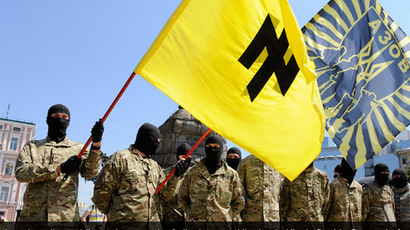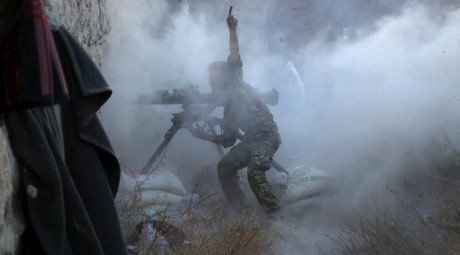Pentagon funding bill on Obama’s desk: $600mn to Syrian rebels, $300mn to Kiev

The defense funding bill for 2016 includes some lavish support to rebels in Syria and lethal aid to the current Ukrainian government. Although President Barack Obama is at loggerheads with lawmakers over some of the provisions, they are likely to remain.
Obama has threatened to veto the $612 billion National Defense Authorization Act – also known as House Resolution 1735, or the NDAA – because it contains provisions blocking the plans to shut down the detention camp at the US base in Guantanamo Bay, and because it avoids a cap on defense spending by padding a special account reserved for bankrolling wars. The Senate passed the NDAA on Wednesday with a veto-proof majority.
While the White House and the lawmakers are in dispute over the details, they appear to be in agreement on continuing to send military aid to the regime in Ukraine and the elusive “moderate rebels” in Syria.
Some $600 million has been earmarked for a program to support the “appropriately vetted” Syrian rebels, fighting against both the government in Damascus and Islamic State (IS, also known as ISIS and ISIL).
Section 1225 of the NDAA allocates $531.5 million directly to the Syria Train and Equip program, and directs an additional $25.8 million to the US Army and $42.8 million to the US Air Force, to cover the costs of their participation.
The 2015 version of the NDAA allocated $500 million for the training and equipping of “moderate rebels.” Though the Pentagon hoped to have a force of 5,000 fighters by the end of 2015, the program has produced only a handful – literally. Top US military officials admitted only “five or six” rebels remained in combat after the first group was scattered by Al-Nusra terrorists in July. The second batch of rebels surrendered to Al-Nusra last month, with all their US-provided gear.
US-trained Syrian rebels with weapons end up in hands of Nusra jihadists http://t.co/xTSkKzUdCypic.twitter.com/EZbPXVycFB
— RT (@RT_com) September 23, 2015The text of the bill as reconciled between the House of Representatives and the Senate lays out the conditions for the aid, including the provision that the Pentagon must prevent the weapons, ammunition and supplies given to the rebels from falling into the hands of IS, Al-Nusra, Al-Qaeda, the Khorasan Group, “any other violent extremist organization,” as well as “Syrian Arab Army or any group or organization supporting President Bashir [sic] Assad.”
Washington insists that the government of President Assad is the “root of all evil” in Syria and that regime change in Damascus should be pursued parallel to the struggle against Islamic State.
Another $715 million was allocated for the train-and-equip program in Iraq, aimed at the Iraqi military as well as the Kurdish and tribal militias fighting against IS.
Though the US-led coalition of 62 countries has been bombing IS in Syria and Iraq for over a year, at a total cost of $4 billion and counting, the group has grown in strength and expanded its reach. On September 30, Russia began its own air campaign against IS, in cooperation with the governments of Syria, Iraq and Iran.
Another provision in the NDAA gives the Pentagon and the State Department a six-month deadline to report on the possibility of establishing and maintaining a no-fly zone “over a significant portion or all of Syria” and “one or more safe zones in Syria for internally displaced people or for the facilitation of humanitarian assistance.”
Plans to establish a no-fly zone and “safe areas” have been floated by former CIA director and retired US Army General David Petraeus and by contender for the Democratic presidential nomination Hillary Clinton.
"Lethal assistance" to Ukraine
Section 1250 of the NDAA allocates $300 million to the “Ukraine Security Assistance Initiative,” aimed at propping up the government in Kiev. The bill instructs the Pentagon to coordinate with the State Department to “provide appropriate security assistance and intelligence support, including training, equipment, and logistics support, supplies and services, to military and other security forces of the Government of Ukraine.”
Lawmakers have allocated no less than $50 million for “Lethal assistance such as anti-armor weapon systems, mortars, crew-served weapons and ammunition, grenade launchers and ammunition, and small arms and ammunition.”
US lawmakers ban aid to Ukraine neo-Nazis http://t.co/xiTMexAbCppic.twitter.com/efyiEHqyDS
— RT America (@RT_America) June 12, 2015US troops have been training Ukrainian government soldiers at Yavoriv, in western Ukraine, since this spring. However, this is the first time that Washington has authorized lethal aid for Kiev. The program also includes drones – described as “unmanned aerial tactical surveillance systems” – as well as electronic and cyber warfare capabilities and “actionable intelligence.”
The final version of the bill does not specify what it means by “other security forces.” In addition to the state military, the Kiev regime has used the newly formed National Guard and volunteer battalions such as ‘Azov,’ described by US lawmakers as “openly neo-Nazi” and “fascist.”














